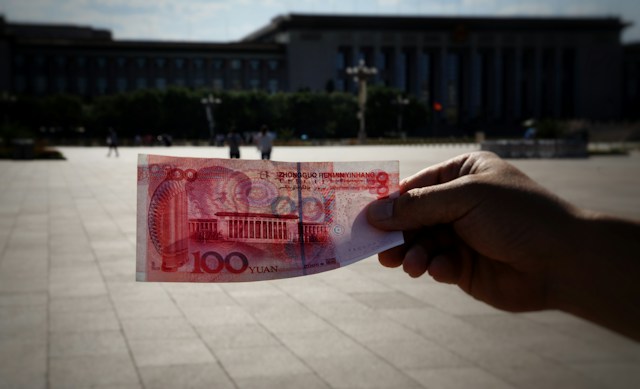In an age defined by growing environmental awareness and rapid technological progress, the intersection of digital currencies and carbon credits stands as a powerful catalyst for revolutionizing the world of finance. This article explores the realm of green investment, shedding light on the exciting partnership between the digital yuan and carbon credits—an alliance with the potential to shape a sustainable future. Positioned at the forefront of this transformative initiative is a key player, yuanglobalrevolution.com, taking on a pivotal role in facilitating the development of an eco-friendly financial landscape, ensuring a more environmentally responsible and technologically advanced approach to global finance.
Understanding Digital Yuan
What is digital yuan, and how does it differ from traditional currency?
The digital yuan, or e-CNY, is China’s central bank digital currency (CBDC). Unlike traditional currencies, it exists only in digital form, representing a government-backed cryptocurrency. Its primary aim is to provide a secure, efficient, and traceable means of transaction, ultimately reducing reliance on physical cash.
Motivations behind China’s development of a digital currency
China’s move towards digital yuan stems from several factors, including a desire to combat financial crime, enhance monetary policy effectiveness, and establish a more inclusive financial system. It also aligns with China’s aspiration to bolster the global standing of its currency.
The potential benefits of using digital yuan in green investing
Digital yuan can facilitate seamless cross-border transactions in the carbon credit market, reducing transaction costs and enhancing transparency. It provides a secure and efficient means of transferring funds for sustainable investments, supporting the global transition to a greener economy.
Carbon Credits: A Sustainable Investment
What are carbon credits, and how do they work?
Carbon credits are tradable certificates representing a reduction in greenhouse gas emissions. They are typically earned by companies and organizations that implement emission reduction projects. These credits can be bought and sold in carbon markets, allowing entities to offset their emissions by supporting environmental initiatives.
The global carbon market and its growth in recent years
The carbon market has witnessed substantial growth, driven by international climate agreements like the Paris Agreement. The market’s expansion indicates a collective effort to combat climate change and transition to a low-carbon economy.
The role of carbon credits in supporting renewable energy and emission reduction projects
Carbon credits play a crucial role in financing renewable energy projects, reforestation efforts, and innovative emission reduction technologies. They incentivize sustainable practices and offer financial rewards for environmentally responsible initiatives.
Green Investing: A Growing Trend
The increasing interest in sustainable and environmentally responsible investments
Sustainable investing, often referred to as Environmental, Social, and Governance (ESG) investing, has gained momentum. Investors are increasingly prioritizing ethical and sustainable practices, aligning their portfolios with their values.
The benefits of green investing for both individuals and institutions
Green investments not only contribute to a more sustainable planet but also offer potential financial rewards. They provide diversification opportunities, mitigate long-term risks, and align with regulatory and societal expectations.
The potential returns and risks associated with green investments
While green investments offer the promise of positive returns, they are not immune to risks. Investors must consider market fluctuations, regulatory changes, and the performance of sustainable assets.
Digital Yuan’s Role in Green Investing
How digital yuan can facilitate international carbon credit transactions
Digital yuan’s efficiency and traceability make it an ideal medium for cross-border carbon credit transactions. It reduces the complexities associated with traditional fiat currencies and minimizes transaction costs.
The potential for blockchain technology to enhance transparency in carbon credit markets
Blockchain technology can be integrated into carbon credit systems to ensure transparent and tamper-proof records of emissions reductions. This level of transparency can instill confidence in investors and regulators.
Case studies of companies and organizations using digital yuan for green investments
Several organizations have begun using digital yuan for green investments. Notable examples include multinational corporations investing in renewable energy projects and financial institutions exploring sustainable investment products.
Challenges and Considerations
Regulatory hurdles and concerns surrounding the use of digital yuan in global finance
The global adoption of digital yuan faces regulatory challenges, as different countries have varying approaches to digital currencies. Concerns about data privacy and security must also be addressed.
The evolving landscape of carbon credit standards and verification
Carbon credit standards and verification processes are still evolving, making it essential to have robust mechanisms for ensuring the legitimacy and impact of carbon credit projects.
Strategies for mitigating risks in green investments with digital yuan
Investors must adopt risk mitigation strategies such as diversification, thorough due diligence, and staying informed about evolving regulations and market trends.
The Future of Green Investing
Emerging trends in green finance and technology
The future of green investing will likely witness continued growth, with advancements in sustainable technologies and financial products. Innovations in carbon credit markets and digital currencies will further shape the landscape.
The role of governments, financial institutions, and investors in shaping the future of green investing
Collaboration among governments, financial institutions, and investors is crucial in accelerating the transition to a sustainable global economy. Policymakers must create conducive environments, and financial institutions should develop innovative green investment products.
Conclusion
In a world facing the urgent challenges of climate change and environmental degradation, the fusion of digital currencies like the digital yuan with carbon credits offers a path to green investing that can have a lasting impact. As we navigate the complexities of this transformative intersection, it is crucial for individuals and institutions alike to explore green investment opportunities, harnessing the power of digital currencies and carbon credits to drive positive change and create a more sustainable future.

0 Comments